Table of Contents
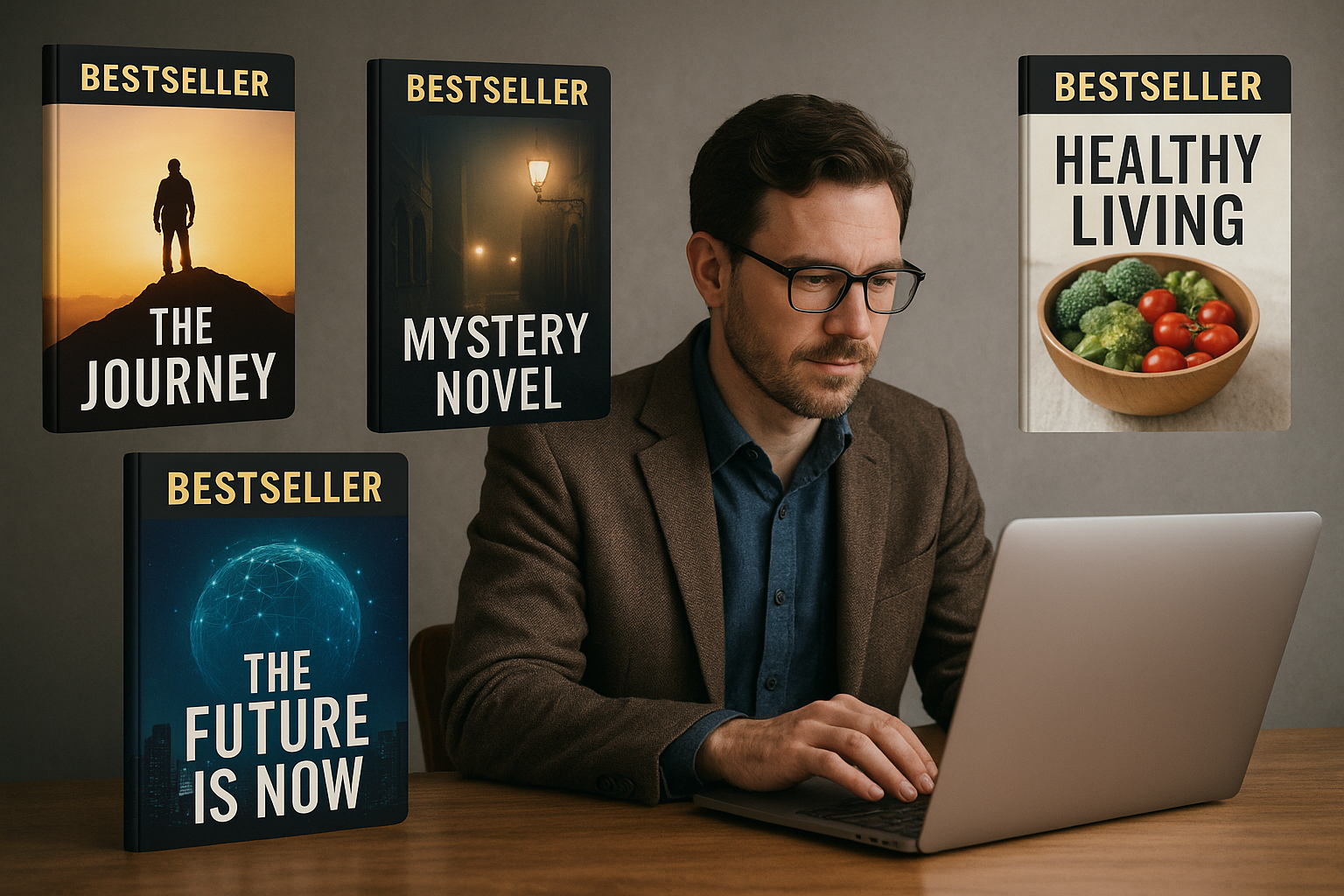
Imagine waking up tomorrow morning and discovering something extraordinary has happened while you slept.
Your phone buzzes with notifications. Sales alerts. Download confirmations. Reviews from readers you’ve never met, thanking you for changing their lives. What if I told you that by tomorrow, your knowledge could be circulating all over the world—everyone reading what you’ve written, absorbing wisdom you gained from working your whole life that was stuck in your mind for ages?
This isn’t fantasy. This is the reality for thousands of authors who discovered the secret to transforming their trapped expertise into income streams that continue growing long after they’ve finished writing.
Sounds amazing, right? But here’s what makes this story even more compelling—it has been done by ordinary people who struggled in their work for ages, until one pivotal moment changed everything.
The Transformation Stories That Will Inspire You
Michael J. Sullivan spent over ten years trapped in the traditional publishing maze, collecting rejection after rejection. His knowledge seemed worthless, his stories unwanted. Then he made one decision that changed everything—he chose to self-publish. Within just five months, he earned more than $102,000 and eventually secured a six-figure contract from Orbit, the fantasy imprint of Hachette Book Group.
Amanda Hocking was a struggling writer who just wanted to make $300 for a trip to see a Muppet exhibition. She had stories in her head but no way to share them profitably. One year after self-publishing her paranormal romance novels on Amazon, she had sold over a million copies and became one of the first self-published authors to earn millions.
Lisa Genova, a Harvard-educated neuroscientist, faced the same crushing reality—constant rejections from traditional publishers. An agent even warned her, “Don’t self-publish. You’ll kill your writing career before it begins.” She ignored that warning, and her strategic approach led to a six-figure deal with Simon & Schuster and an Oscar-winning film adaptation starring Julianne Moore.
What connects all these stories? Each of these authors had valuable knowledge locked away in their minds. Each faced rejection and doubt. But each discovered the transformative power of turning their expertise into eBooks that work tirelessly on their behalf.
The Market Opportunity That’s Waiting for You
The timing has never been better.
Right now, we’re witnessing the largest shift in publishing history, and the numbers prove it:
- $15.33 billion eBook market by 2027
- 1 billion readers hungry for content by 2025
- Self-published authors dominating with 2+ million more titles than traditional publishers
- 2,000+ indie authors already earning six figures
Here’s the most exciting part: With platforms like Amazon’s Kindle Unlimited—a subscription service where readers access thousands of eBooks—authors earn 50-75% of their income while readers pay pennies per page. This creates true passive income that works while you sleep.
Your Complete Transformation Blueprint
By the time you finish reading this comprehensive guide, you’ll have everything needed to join the ranks of successful eBook entrepreneurs. This isn’t just another “how-to” article—it’s your complete transformation blueprint, designed in three interconnected parts that build upon each other to create your eBook empire.
Part 1: Mastering the Art of eBook Creation
The Foundation That Changes Everything
Picture this: You’re sitting at your computer, staring at a blank document, overwhelmed by a paralyzing question that has stopped countless would-be authors dead in their tracks: “What should I write about?”
This moment separates the dreamers from the earners.
The authors making six figures didn’t stumble upon success by accident. They discovered something powerful—a systematic approach to eBook creation that transforms scattered knowledge into profit-generating assets. What you’re about to learn isn’t just theory—it’s the exact blueprint used by authors like Michael J. Sullivan, who earned over $102,000 in five months, and thousands of others who’ve cracked the code.
Your journey from knowledge worker to eBook entrepreneur begins with mastering four interconnected pillars that successful authors never skip. Each builds upon the last, creating an unstoppable foundation for your eBook empire.
1.1 Finding Your Profitable Topic: The Sweet Spot Discovery Method
Most aspiring authors fail before they even begin because they choose topics that feel right but sell poorly.
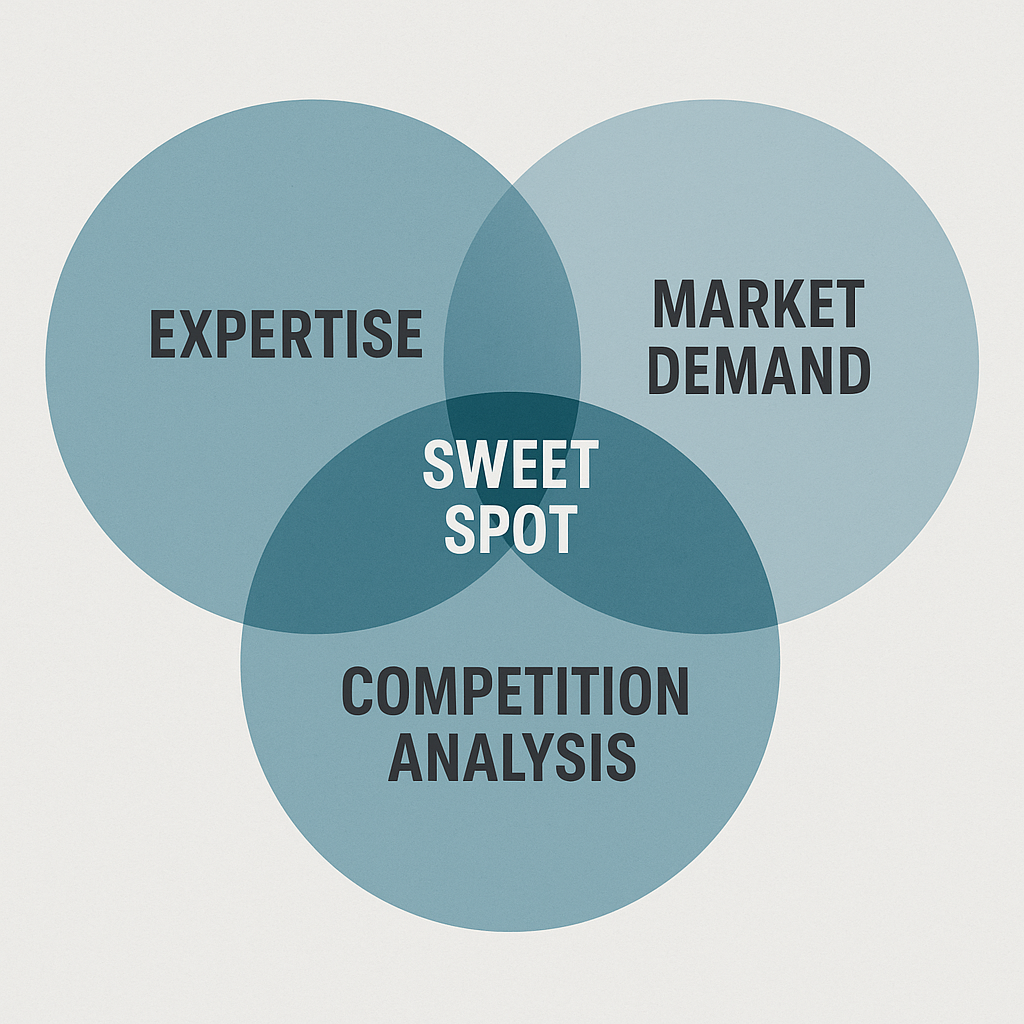
The difference between a hobby project and a money-making eBook lies in discovering what successful authors call “The Sweet Spot”—that magical intersection where your passion, knowledge, and market opportunity converge. This isn’t guesswork; it’s a strategic process that removes the risk from your eBook venture.
The Three-Circle Strategy That Never Fails
Start with the center of your expertise universe—the knowledge you’ve gained from working your whole life that’s been stuck in your mind for ages. But expertise alone doesn’t guarantee profit. You need to find topics that resonate with both your knowledge and market demand.
Here’s your systematic approach:
Circle 1: Your Knowledge Zone
Ask yourself these power questions that successful authors use:
What topics am I genuinely passionate about?
What problems do people frequently ask me for advice on?
What knowledge am I really trained in and experienced with?
The more specific your expertise, the easier it becomes for your eBook to stand out from the competition.
Circle 2: Market Demand Detection
This is where amateur authors stumble and professionals thrive. You must validate that people are actively searching for solutions in your expertise area. Understanding your target audience is the first step in conducting comprehensive topic research—demographics, interests, preferences, and most
importantly, their burning problems.
Circle 3: Competition Analysis
Browse through Amazon’s bestseller lists to identify popular topics and genres.
Pay attention to recurring themes and gaps in the market that present
opportunities for your unique contribution. Study customer reviews and ratings
for books within your desired genre to understand what readers appreciate and
what they feel is lacking.
Research Techniques That Separate Professionals from Amateurs
Google Trends: Your Market Validation Weapon
Google Trends is a web-based tool for in-depth keyword research that provides wealth of data on how and when keywords are used. Search for topics related to your expertise and analyze popularity over time, regional interest, and related searches. This tells you whether interest in your topic is growing or declining—crucial information for long-term success.
Amazon’s Hidden Intelligence
Amazon calculates Best Sellers Ranks using sales volume data, with recent sales counting more than older sales. Study the top-performing books in your category, but don’t just look at titles—read the book descriptions, browse sample chapters, and identify their unique selling points. More importantly, analyze customer reviews to find patterns in positive and negative feedback.
Social Media Goldmine
Engage with online communities and forums related to your target audience and topic. Platforms like Reddit, Facebook groups, and LinkedIn discussions provide valuable insights into readers’ questions, interests, and pain points. This real-time market research reveals exactly what your audience desperately wants to know.
The Validation Step That Saves Years of Wasted Effort
Before investing significant time and effort, validate your ideas through direct audience feedback. Create surveys or reach out through social media to collect feedback on potential book ideas. This single step prevents the heartbreak of writing a book nobody wants to buy.
The bottom line: Finding your profitable topic isn’t about following your passion blindly—it’s about strategically positioning your expertise where it can serve the most people and generate the most income.
1.2 Crafting Your eBook Structure: The Transformation Blueprint
Here’s a truth that will revolutionize your approach: readers don’t buy information—they buy transformation.
Your eBook structure isn’t just organization; it’s a carefully designed journey that guides readers from their current frustration to their desired outcome. Master storytellers and successful eBook authors use proven frameworks to maintain engagement throughout their content.
The Psychology Behind Irresistible eBook Flow
Every successful eBook follows what professionals call “The Transformation Arc”—a logical progression that mirrors how people actually learn and change. Stories work because people like familiarity, and narratives that follow familiar structure patterns keep readers engaged.
The Hero’s Journey for eBook Authors
Adapted from storytelling masters, your eBook should follow this proven structure:
The hero (your reader) faces a challenge → encounters obstacles → receives guidance (your expertise) → overcomes difficulties → achieves transformation.
This story structure works because it follows familiar narrative patterns that readers instinctively understand.
The Three-Act Structure for Maximum Impact
Act 1: Setup (25% of your eBook)
Establish your reader’s current situation and the problem they’re facing7. This is where you build empathy and credibility. The exposition should establish the protagonist’s normal life and greater desires, usually culminating in an inciting incident—the moment they realize they need change.
Act 2: Confrontation (50% of your eBook)
This is where your reader pursues their goal and faces challenges along the way. Provide your core content here, but structure it as rising action where your reader grows familiar with new concepts and encounters both allies (supporting ideas) and enemies (common obstacles).
Act 3: Resolution (25% of your eBook)
Show your reader how to achieve their transformation and maintain their new state. The resolution should tie together all plot points and character arcs while establishing a new status quo—their improved life after implementing your guidance.
Chapter Organization That Keeps Readers Hooked
Each chapter should function as a mini-transformation, building upon the previous one while creating anticipation for what’s next. Use compelling outlines that guide readers through transformation step-by-step. End each chapter with a “bridge” that creates curiosity about the following section—the same technique used by binge-worthy Netflix series.
The power of this approach: When readers feel they’re on a clear path to transformation, they become invested in completing the journey. Logical flow and strategic chapter organization prevent readers from abandoning your eBook halfway through.
1.3 Writing Compelling Content: The Conversion Code
Here’s what separates eBooks that sell from those that gather digital dust: the ability to write content that converts browsers into buyers.
Your writing style directly impacts whether readers recommend your eBook to others, leave positive reviews, or purchase your future works. The difference between amateur and professional eBook content isn’t talent—it’s understanding specific techniques that create engagement and drive action.
The Engagement Techniques That Keep Readers Glued
Use Active Voice for Maximum Impact
Passive voice clouds the meaning of your copy, while active voice creates concise and actionable content. Instead of writing “Mistakes can be avoided by following these steps,” write “Follow these steps to avoid mistakes.” Active voice grabs your audience’s attention and makes your guidance feel immediate and personal.
Lead with Hooks That Demand Attention
Don’t be afraid to say something compelling or thought-provoking—as long as it’s relevant to what your audience cares about. Ask questions, share controversial insights, or present trending perspectives that give readers something to agree or disagree with. When crafting hooks, write through a lens of empathy and authenticity.
Break Complex Concepts into Digestible Chunks
Using headers and sub-headers draws readers’ attention while keeping content organized and on track. Lists are engaging because they’re easy to follow, understand, and skim. Transform dense information into scannable formats that provide immediate value without overwhelming readers.
The Psychology of Persuasive Writing
Use Graphics and Examples Strategically
Graphics such as pictures, charts, or graphs are powerful ways to increase engagement and convey ideas more effectively than text alone9. Visual elements help readers understand complex concepts quickly and make your content more memorable.
Incorporate Interactive Elements
Modern eBooks aren’t just text—they’re multimedia experiences that can include interactive features to enhance engagement. While keeping your core content strong, consider how worksheets, checklists, or reflection questions can make your eBook more valuable and actionable.
Every piece of content should have a clear call to action. Guide readers on what to do next, whether that’s implementing a strategy, moving to the next chapter, or taking action in their real life. CTAs should vary throughout your content to maintain engagement without becoming repetitive.
1.4 Professional Presentation: The Silent Salesperson
Your eBook’s visual presentation is working 24/7 as your silent salesperson—either attracting readers or driving them away before they read a single word.
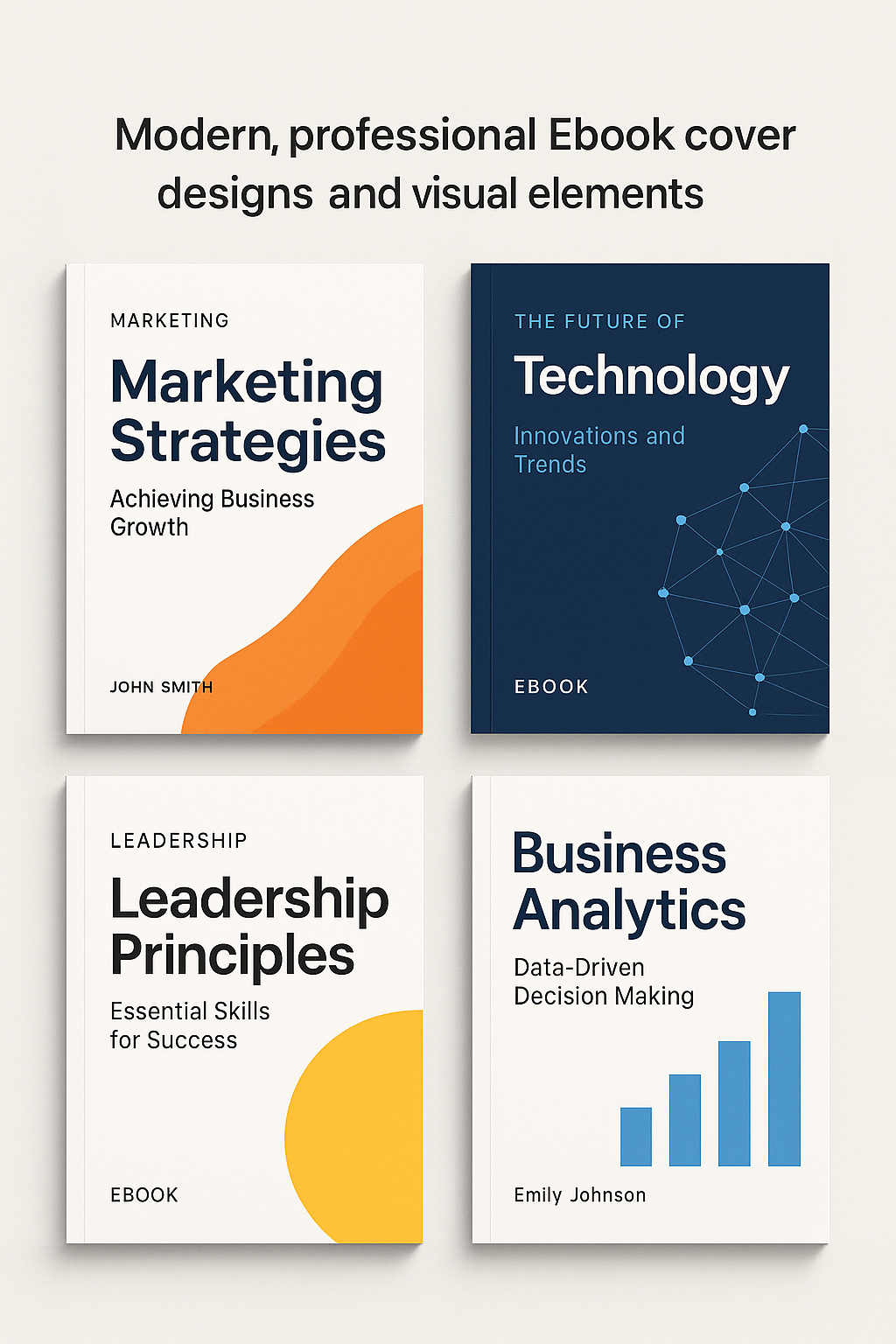
Today’s readers hold eBooks to the same standards as printed books, making professional design more important than ever. The difference between amateur and professional presentation can determine whether your eBook gains traction or gets lost in the digital noise.
Design Principles That Sell Before Readers Read
The Psychology of First Impressions
Your front cover functions as a preview that helps readers decide whether to invest their time and money. Research shows that successful eBook covers follow specific design principles that create immediate visual impact. Close to 70% of successful eBook covers use Ockham’s Razor principle—keeping only essential elements rather than overwhelming viewers with details.
Typography That Commands Attention
Your cover typography should showcase the title in a design-friendly way that doesn’t overwhelm imagery while maintaining balance. Legibility is crucial—readers must be able to read your title clearly in thumbnail size on digital platforms. The Picture Superiority Effect confirms that images are more immediately recognized and better recalled than text, but your text must work harmoniously with visual elements.
Cover Design Elements That Trigger Purchase Decisions
Genre Recognition Signals
Your cover should let readers immediately know your book’s genre while giving them a sneak peek of what’s coming. Different genres have established visual conventions that readers expect—business books often use clean, professional designs while self-help books might incorporate more inspirational imagery.
The Rule of Thirds and Visual Hierarchy
Professional covers use the Rule of Thirds to create visually appealing compositions. Hierarchy ensures that the most important elements (title, author name) are prominently displayed while supporting elements enhance rather than compete. Proximity and similarity principles help group related elements and create cohesive designs.
Formatting That Enhances the Reading Experience
Professional eBook formatting ensures optimal user experience across all devices and platforms. Standard formatting for eBooks features dynamic, re-flowable layouts that look great on every size eReader, mobile device, and tablet.
Essential Formatting Elements:
- Clear hierarchy with consistent heading styles
- Readable typography that works across all devices
- Proper chapter breaks and section divisions
- Optimized images that load quickly and display correctly
File Format Considerations
Different platforms require specific formats—EPUB for most retailers, MOBI for Amazon Kindle, and PDF for direct sales. Understanding platform requirements ensures your eBook displays correctly and professionally regardless of where readers access it.
The Foundation is Set—Now the Real Magic Begins
Now that you’ve mastered the art of eBook creation—from finding your profitable topic to crafting compelling content with professional presentation—you possess the foundation that separates successful authors from those whose books never find their audience.
But creating an outstanding eBook is only the beginning of your transformation.
The authors earning six figures didn’t stop at writing great content. They discovered the sales strategies and marketing systems that turn excellent eBooks into money-making machines that generate income while they sleep.
Part 2 reveals the sales strategies that separate successful authors from those whose books gather digital dust. You’ll discover the exact platforms, pricing psychology, and conversion techniques that transform your valuable eBook into a profitable business asset…
Part 2: The Sales Machine – Converting Your eBook into Revenue
Where Knowledge Becomes Profit
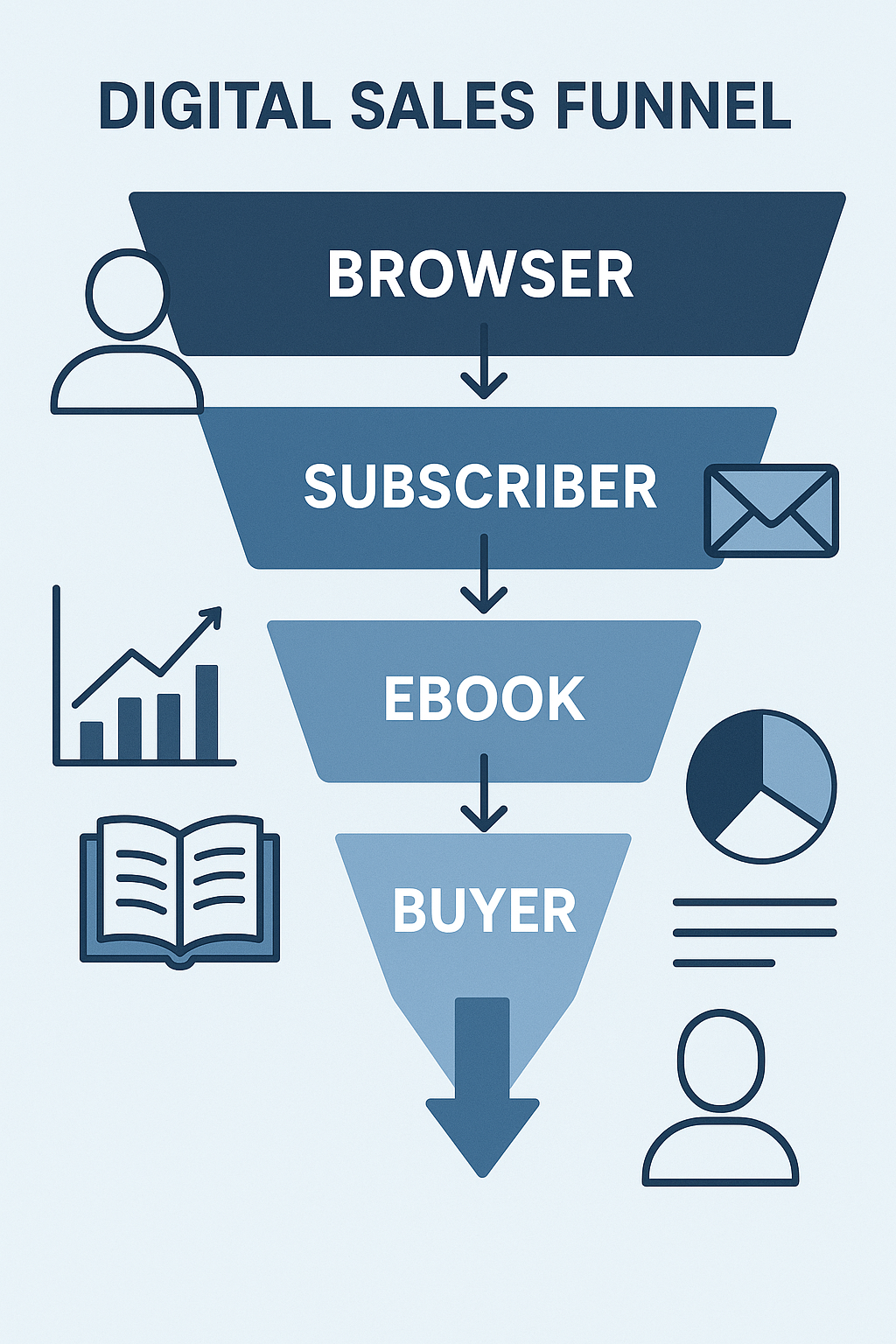
You’ve crafted an eBook that delivers real value—one that guides readers through transformation with compelling content and professional presentation. But here’s the brutal truth that stops most authors dead in their tracks: having a great eBook means nothing if nobody buys it.
The difference between authors who earn thousands and those whose books gather digital dust isn’t talent—it’s mastering the sales machine.
This is where your transformation from writer to entrepreneur truly begins. You’re about to discover the exact strategies that turn excellent eBooks into consistent income streams, the same techniques used by authors earning over $100,000 in royalties .
2.1 Platform Selection Strategy: Choose Your Battlefield Wisely
Your platform choice can make or break your eBook empire before you even begin.
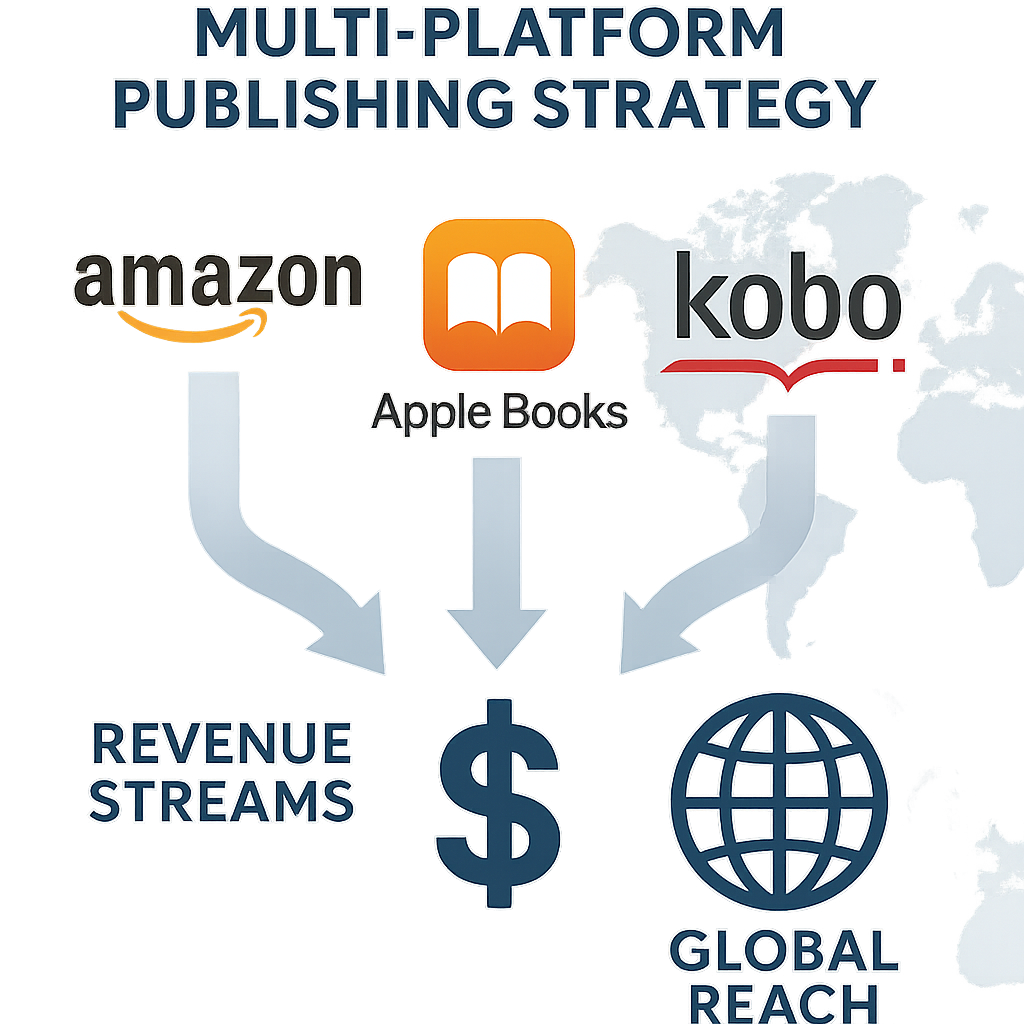
Amazon Kindle Direct Publishing (KDP) commands over 80% of the self-publishing market , but smart authors understand that different platforms serve different strategic purposes . Think of this as choosing your battlefield—each platform has unique advantages that can accelerate or hinder your success .
The Amazon Advantage: Where the Money Lives
Amazon KDP offers up to 70% royalty rates for books priced between $2.99 and $9.99 , with a 35% rate outside that range . More importantly, Amazon provides direct access to millions of potential readers through its massive global audience . The Kindle Unlimited program alone creates substantial passive income, with KU payouts making up 50% to 75% of most indie authors’ income .
Here’s what makes Amazon unstoppable: Built-in audience discovery, fast publishing times, and user-friendly dashboard management . When you publish on KDP, you’re not just listing a book—you’re plugging into a sales machine that works 24/7 .
Beyond Amazon: Strategic Diversification
Smart authors don’t put all their eggs in one basket. Apple Books offers up to 70% royalties with no exclusivity requirements , making it perfect for reaching premium markets, especially in English-speaking countries . Kobo Writing Life provides 45-70% royalties with strong international distribution, particularly in Canada and Europe .
The key insight: Use Amazon for volume and discovery, then expand to other platforms for geographic and audience diversification . This multi-platform approach can increase your total revenue by 20-40% .
2.2 Pricing Psychology: The Science of Maximum Profit
Your price isn’t just a number—it’s a psychological trigger that determines whether browsers become buyers.
Research shows that pricing ending in .99 can boost sales by 24% to 60% . This “charm pricing” taps directly into the subconscious mind, making $4.99 seem significantly cheaper than $5.00 . But here’s where most authors get it wrong—they think lower prices always mean more sales.
The Premium Positioning Secret
Premium pricing can actually increase sales by signaling higher quality and expertise . If you wrote a comprehensive guide, pricing it at $17.00 instead of $4.99 positions your book as authoritative and valuable . About 67% of shoppers buy impulsively when they perceive they’re getting value for money .
Strategic pricing insight: Test both odd numbers ($13.97) for value-seekers and even numbers ($14.00) for quality-focused buyers . Let your audience tell you what converts best .
Price Anchoring: The $1 Million Technique
Create a premium bundle version at $14.99 alongside your regular $7.99 eBook . Readers will perceive your standard version as incredibly valuable and affordable . This mental shortcut—called price anchoring—nudges people to buy faster without overthinking .
2.3 Copywriting That Converts: Words That Sell While You Sleep
Your sales copy is working 24/7 as your silent salesperson—either attracting readers or driving them away.
The difference between amateur and professional eBook sales pages isn’t creativity—it’s understanding proven psychological triggers that compel action . Successful sales pages follow specific formulas that convert browsers into buyers .
The PAS Formula: Problem-Agitate-Solution
Start by identifying your reader’s specific problem . Then agitate that pain point by showing the consequences of not solving it . Finally, present your eBook as the definitive solution . This formula works because it mirrors how people actually make purchasing decisions .
Example: “Struggling to find profitable eBook topics? Every day you delay means money left on the table while competitors capture your potential readers. This guide reveals the exact research methods that successful authors use to identify six-figure topics.”
The AIDA Structure: Attention-Interest-Desire-Action
Grab attention with a compelling headline . Build interest by highlighting unique benefits . Create desire by showing transformation possibilities . Drive action with clear, urgent calls-to-action .
Professional copywriting insight: Use active voice and address objections before readers think of them . Include social proof through testimonials and success stories to build trust .
2.4 Building Unshakeable Trust: Social Proof That Sells
In the digital world, trust is your most valuable currency—and social proof is how you earn it.
Displaying customer reviews can boost eBook conversion rates by up to 67% . Testimonials can increase conversions by 34% . But here’s what most authors miss—not all social proof is created equal .
The Testimonial Hierarchy
Expert endorsements carry the most weight, followed by customer success stories, then volume indicators . One endorsement from a recognized authority in your field outweighs dozens of generic reviews .
Strategic approach: Collect specific, result-focused testimonials that highlight transformation . Instead of “Great book!” seek “This book helped me increase my freelance income by 40% in three months.”
Overcoming Digital Product Skepticism
Digital products face unique trust challenges—buyers can’t physically examine them . Combat this with money-back guarantees, detailed previews, and author credibility indicators . Share your qualifications, experience, and previous successes to build authority .
Trust-building technique: Create urgency without manipulation by highlighting limited-time bonuses or exclusive access . Use phrases like “Join 2,000+ successful authors” to show popularity and community .
Your Sales Foundation is Set—Now Scale to the Sky
You’ve mastered platform selection, pricing psychology, conversion copywriting, and trust-building techniques. Your eBook is no longer just a digital file—it’s a profit-generating asset with the systems to sell consistently.
But successful authors don’t stop at individual sales. They build empires that generate multiple income streams from their expertise, creating marketing systems that work while they focus on what they love most—writing and teaching.
Part 3 reveals how to scale your success through strategic marketing, author platform building, and systematic growth that transforms your single eBook into a thriving business ecosystem…
Part 3: Scaling Success – Building Your eBook Empire
Turning One Hit Wonder into a Sustainable Business
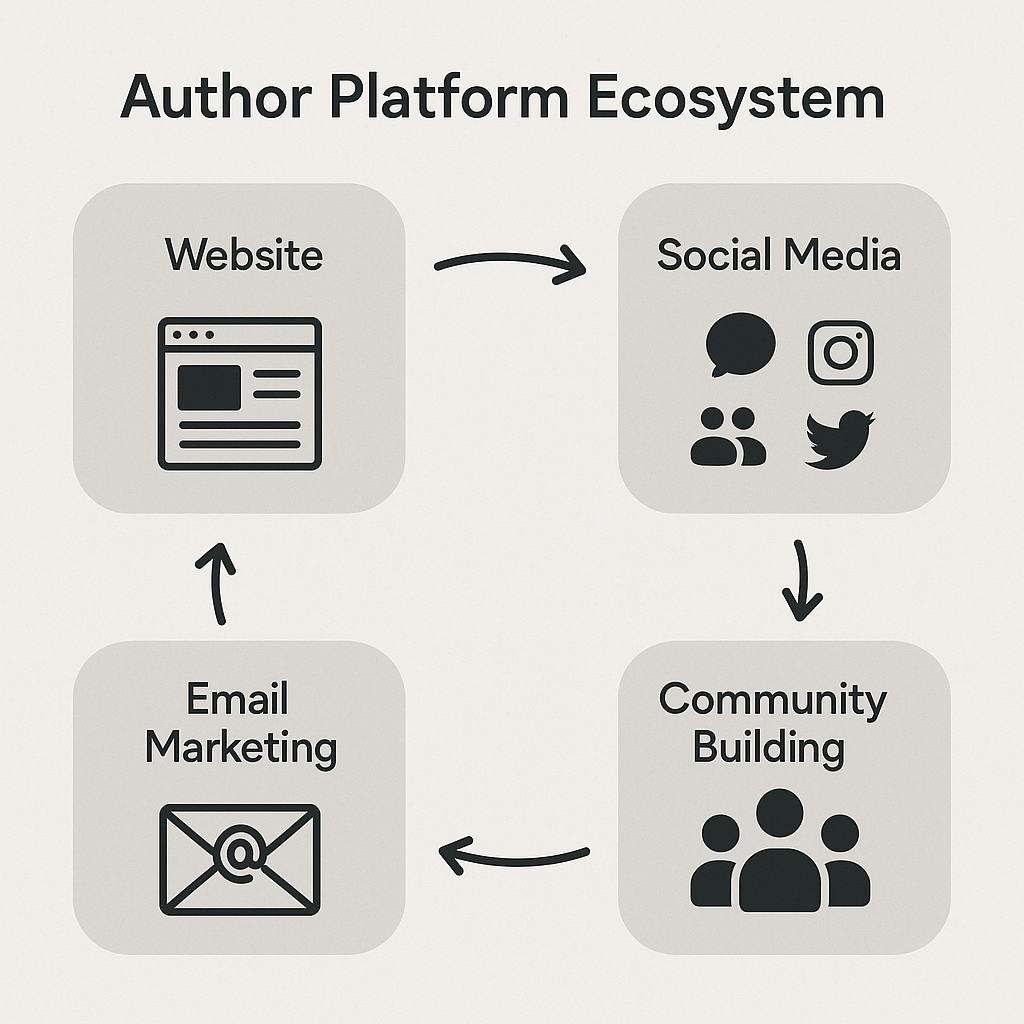
You’ve written a standout eBook and mastered the sales machine. Now it’s time to amplify your reach, deepen reader engagement, and create an ecosystem that grows even when you step away from your keyboard. Part 3 reveals how to turn your single eBook into a thriving, multi-channel business that compounds success over time.
3.1 Multi-Channel Marketing: Meet Readers Where They Are
Your readers don’t live in one place—neither should your marketing.
- Social Media Storytelling: Craft bite-sized insights, behind-the-scenes peeks, and reader testimonials for platforms like Instagram and LinkedIn. Use short video reels or carousel posts to showcase key lessons from your eBook and direct followers to your sales page.
- Email Nurture Sequences: Don’t just send a one-off launch email. Build an automated series that teases a problem, shares a micro-lesson, and invites readers to learn more with your eBook. Sequence your content to turn casual subscribers into loyal buyers.
- Content Marketing Authority: Publish blog posts, guest articles, or podcasts on topics adjacent to your eBook’s theme. Each piece should link back to your book, reinforcing your expertise and driving organic traffic.
3.2 SEO & Discoverability: Be Found, Not Forgotten
Great eBooks don’t matter if no one can find them.
- Keyword-Rich Metadata: Optimize your title, subtitle, and book description with high-intent keywords your audience searches for. Use tools like Google Keyword Planner or Publisher Rocket to pinpoint terms readers use right now.
- On-Page Backlinks: Write authoritative articles on your website or guest-post on niche sites, linking back to your eBook landing page. This builds domain authority and boosts search rankings.
- Platform Algorithms: On Amazon, rotate targeted keywords, tweak your categories, and encourage early reviews to trigger “Also Bought” and “Customers Also Viewed” recommendations.
3.3 Building Your Author Platform: Your Most Valuable Asset
Your brand is more than a logo—it’s a promise of value.
- Author Website Hub: Create a dedicated site with a blog, free resources (e.g., a downloadable checklist), and an email capture form. Every page should guide visitors toward your eBook and future offerings.
- Community & Social Proof: Foster a private Facebook group, Discord channel, or LinkedIn community for readers. Encourage discussion, host live Q&A sessions, and surface user-generated success stories that reinforce your authority.
- Lead Magnets & Upsells: Offer short, high-value freebies—like a 5-step worksheet—that require an email sign-up. Once subscribers trust your content, present premium offers: workbooks, video courses, or consulting packages.
3.4 Systematizing Growth: The Evergreen Machine
Sustainable success demands repeatable processes.
- Content Calendar Blueprint: Plan quarterly themes that align with your eBook chapters. Schedule social posts, blog articles, webinars, and email campaigns in advance to maintain momentum.
- Performance Tracking: Monitor key metrics—conversion rates, open rates, ad ROI—and run A/B tests on headlines, pricing, and calls-to-action. Use insights to refine every element of your marketing machine.
- Product Line Expansion: Leverage your existing eBook by creating sequels, workbooks, or translation editions. Each new format broadens your audience and unlocks fresh revenue streams.
You’ve now built more than an eBook—you’ve created a self-sustaining business that grows with every new reader, social share, and strategic launch.
Next Up: The Grand Finale
Conclusion: Your eBook Empire Awaits
You’ve journeyed from the spark of an idea to building a professional, profit-generating eBook—and now you stand at the threshold of scaling that success into a true empire. Part 1 showed you how to pinpoint the perfect topic, craft a transformational outline, and write content that converts. Part 2 revealed the sales engine—selecting the right platforms, pricing with precision, and writing persuasive copy that drives purchases. Part 3 taught you how to amplify your reach through multi-channel marketing, SEO mastery, platform building, and repeatable growth systems.
Now it’s time to take decisive action:
- Solidify Your Foundation: Review your eBook outline and ensure every chapter guides readers toward transformation.
- Launch with Confidence: Choose your primary distribution platform, set strategic pricing, and craft a sales page that uses PAS or AIDA to convert browsers into buyers.
- Activate Your Marketing Machine: Schedule at least three promotional tactics this week—an email sequence, a social media teaser, and a guest blog post—to drive early momentum.
- Build Your Community: Invite your readers into a dedicated space—an email list, a private group, or a webinar—where you can nurture relationships and gather feedback.
- Plan for Scale: Sketch out one new offering (workbook, course, or bundle) that complements your eBook and brainstorm how you’ll promote it six weeks from now.
Ready to see real results? Start today. Take one step—outline a promotional email, grab your keyword tool, or sketch your next chapter’s hook—and watch how momentum builds.
Free 30-Minute Marketing Strategy Call
Ready to transform your marketing and boost your ROI? For a limited time, we’re offering 50 free 30-minute 1-on-1 marketing strategy calls to help businesses like yours double their revenue in just 30 days. Here’s what you’ll get:
- Personalized Strategy Session: A step-by-step guide tailored to your business to generate more leads and convert them into loyal customers.
- Proven Funnel System: Learn how to build a high-converting funnel that turns clicks into sales.
- Irresistible Offer Blueprint: Craft offers that keep customers coming back for more.
- 30-Day AI SEO Report Access: Free access to our weekly AI-powered SEO reports with actionable to-do lists to skyrocket your search rankings.
- AI-Driven Insights: Leverage our cutting-edge AI system that analyzes over 100,000 social media posts to uncover market trends, customer sentiment, and opportunities specific to your niche.
Why This Matters: Our AI-driven strategies have helped businesses achieve 3X better performance than traditional marketing campaigns. Don’t miss out on actionable insights you can implement in just one day to see results in 30 days.
Hurry—Only 50 Spots Available! This service will soon launch at $600, but you can secure early access at no cost.
Book Your Free Session Now
Act fast—this offer won’t last long!


Leave A Comment